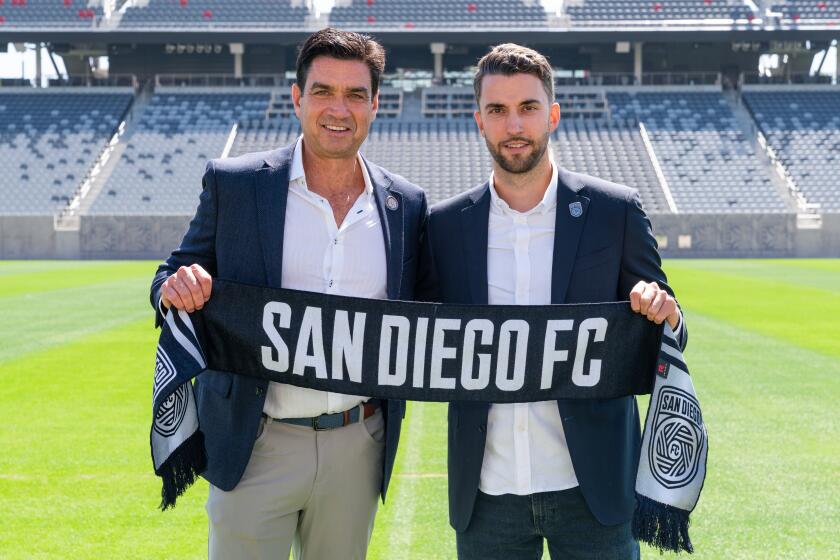GETTING THEIR PIECE OF THE PIE
Itâs a proven business axiom: If you want to know how to make money, talk to those with the dough.
Which is why when Alan Rothenberg wanted to know if Major League Soccer could be a financial success, he sought some business advice from a guy who makes pizza for a living.
Well, not exactly. Rothenbergâs friend is one of the founders of California Pizza Kitchen, a restaurant chain that has been rolling in dough for some time.
âHe told me how they analyzed the success of any restaurants they open,â Rothenberg said, âHe thought--and I think he may be right--that itâs a good standard to use in any business.
âWhen you open, thereâs some curiosity, thereâs some hype, youâve got some Klieg lights, so you get a spike [in public interest]. Then it starts to drop and drop and drop and eventually hits bottom, somewhere a couple of months out.
âThen it gradually starts to build back. And the real key is just into your second year. If just into your second year youâve recaptured what you had in that first spike, thatâs solid business.â
For a league intent on claiming a slice of the American sporting pie, knowing how to read the business signs is crucial.
And so far, halfway through its inaugural season, MLS appears to be surpassing everyoneâs expectations. Attendance is almost double projections, and the on-field product is far better than expected. Television ratings have surprised skeptics and fan interest appears genuine, not transitory.
All of which is not to say that MLS can be declared a success. It might be years before Rothenberg, the leagueâs chairman, can make that claim. But approaching four months into the first season, there are no long faces around MLS headquarters in Century City.
âIn general, itâs been very, very good,â Sunil Gulati, the leagueâs deputy commissioner, said of MLSâ start. âBut itâs fragile. Itâs going to take years to make this thing stable.â
Added Mark Abbott, senior vice president of business affairs: âThe numbers have been fantastic. The attendances have been about twice as high as we had projected. Our sponsorship and licensing are already both above projections. So, overall, I think weâre way ahead of where we thought we were going to be.â
Through its first 97 games, MLS attracted 1,893,182 fans, an average of 19,517 a game. Individually, the Los Angeles Galaxy leads the 10-team league with an average of 40,430, though that figure includes a June 16 doubleheader with the U.S. national team playing Mexico that drew 92,216. Even without that game, the Galaxy is averaging 33,956; the Colorado Rapids have the lowest average at 11,350.
The most pleasing aspect, from the leagueâs standpoint, is that the fans are turning out to watch soccer, not accompanying fireworks displays or rock concerts.
U.S. national team midfielder Tab Ramos was quick to make that point after 78,416 showed at Giants Stadium two weeks ago for MLSâs first all-star game, which was part of a doubleheader with the FIFA all-star game.
âToday, thereâs no doubt that it doesnât matter what the Yankees and Mets are doing,â Ramos said. âAll these people didnât come here because they couldnât make it to a baseball game.â
Itâs all a legacy of World Cup â94, said Bill Sage, the leagueâs senior vice president of operations.
âMy sense was that we would do better than we had projected in terms of our financial models,â he said. âFinancial models are conservative in nature. What we show now is what I thought would be the case, and that is we developed a whole lot of soccer fans during the World Cup. I think a lot of people learned how to be soccer fans. And theyâre still here.
âThe most encouraging thing to me has been the level of enthusiasm of the fans. Ethnic fans have adopted the MLS teams in their local market as their own, and other fans who probably donât have a long tradition of [supporting] soccer have adopted the same sort of chants and cheers that weâve known for years.â
Hispanic fans have been particularly supportive of the league, and not only in such cities as Los Angeles and New York. In part, they validate MLSâ decision to sprinkle what is essentially an American league with players from Central and South America and Africa rather than from Europe.
Encouragingly for MLS, the fans appear to appreciate that such players as the Galaxyâs Jorge Campos and Mauricio Cienfuegos, Tampa Bayâs Carlos Valderrama and others are playing here, while at the same time realizing the truly big names of world soccer are beyond the leagueâs financial means.
For example, Ronaldinho was a 17-year-old bench-warmer on Brazilâs 1994 World Cup-winning team and would seem to be an ideal candidate for MLS.
But immediately after the World Cup, he was sold by his Brazilian club to PSV Eindhoven in the Netherlands for $6 million. Ronaldinho is playing in the Olympic Games, after which he will report to his new club, Barcelona in Spain, which last month bought him from PSV for $22 million.
That is twice the official player budget for the entire MLS. The gulf between the haves and have-nots of the soccer world is immense, and for the moment at least, MLS belongs in the latter category.
It will be decades, if ever, before MLS is able to attract such players. Not only because of money but because to attract the best players in the world a league has to be perceived as one of the best in the world. Hence, the continuing flow of elite players to Italy, England, Germany, Spain, France and the Netherlands.
So MLS is not now--and probably never will be--on the same level as, say, Italyâs Serie A, Germanyâs Bundesliga or Englandâs Premier League. But that does not mean it cannot be an attractive and viable league in its own right.
The key hurdle is the history of failed leagues in the United States, most notably the North American Soccer League, which flourished briefly, then vanished.
It never occurs to anyone to question whether the NFL, NBA, NHL or even Major League Baseball will be around next year or five years from now. To succeed, MLS must enjoy that same fan confidence.
âThe only way you overcome the psychological barrier is to continue to be successful and show that you have stability,â Abbott said. âI think weâve gone a long way to overcoming those kinds of problems by the successes that weâve had this year.
âI think weâve shown that weâre a fairly solid organization and that the backing that we have is real. Weâve got TV contracts for three years and sponsorship contracts for four years and investors with very, very deep pockets. I think the public and the media knows that, and I think theyâre going to come to believe that weâre here to stay.â
Three of the 10 teams--Colorado, the Kansas City Wiz and Tampa Bay Mutiny--have not drawn as well as hoped, but MLS is not ready to talk about expansion or relocation, even though such cities as Chicago, Miami and Seattle are prime candidates.
âI think weâll probably take a very conservative approach toward that,â Sage said. âWeâve got some soft markets, but I donât think we are ready to say those are not good soccer markets.â
The television viewing figures have pleased the league and the networks themselves. MLS games are broadcast weekly on Thursday nights by ESPN2, on Sunday afternoons by Spanish-language Univision, and occasionally by ESPN. The ratings have been solid.
âOur average figure for all telecasts has been 5.6, that translates to 401,000 households on the average every week who are watching,â a Univision spokesman said.
âWeâre pretty much on target. Thatâs exactly where we said it was going to land, and thatâs where itâs landing.â
To give some perspective, Univisionâs weekly telecasts of Mexican League games average a 4.8 rating, so among Spanish-speaking fans, MLS is actually outdrawing Mexican soccer.
âWeâre very pleased with the ratings, especially on ESPN2,â an ESPN spokesman said. âOur average for MLS has been 0.4, and when you compare that to some of our other primary programming on ESPN2, NHL this past regular season was 0.5, college football was at 0.5, menâs college basketball was at 0.3. So MLS is right in there.â
âOn June 6, when L.A. played at New England, it was up against one of the Stanley Cup games on ESPN and it drew an 0.8. An 0.8 for anything on ESPN2 is very good.â
The final word belongs to Gulati.
âI think the best way to look at MLS at the halfway point is compared to expectations,â he said, âand from that perspective it looks very good.
âBut itâs only half a season. Weâve also had some very low attendances and some very bad games. But on average Iâm very pleased with where we are.â
(BEGIN TEXT OF INFOBOX / INFOGRAPHIC)
MLS Attendance *--*
Team Rec Total Att Avg Att Galaxy 13-4 363,871 40,430* NY/NJ MetroStars 9-10 270,801 27,080 New Eng. Revolution 9-9 175,917 19,546 Columbus Crew 6-14 186,253 18,625 San Jose Clash 10-9 187,716 18,771 Dallas Burn 12-9 196,100 17,827 Washington DC United 8-11 134,887 16,861 Tampa Bay Mutiny 11-8 121,782 13,531 Kansas City Wiz 10-11 131,003 13,100 Colorado Rapids 9-12 124,852 11,350
*--*
*--*
Overall (97 games) 1,893,182 19,517
*--*
* Average includes 92,216 who attended June 16 doubleheader featuring United States vs. Mexico.







